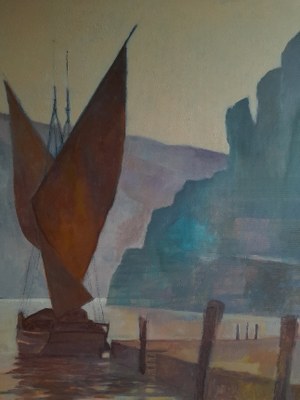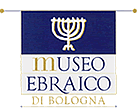FLYING FAR
Andrea Louis Ballardini
THE JEWISH MUSEUM OF BOLOGNA 16 June - 31 August 2024
"It is a dream that I often have: I pick up some sticks or just pull off a branch...I lean on it as one leans on a cane in the street...and that’s enough to make me fly far away in long, outstretched leaps, uphill, downhill, as I please..."
(Franz Kafka, Letter to Max Brod, Schelesen, January 1919)
Throughout his life, the German-speaking Bohemian-Jewish author Franz Kafka (Prague 3 July 1883 - Kierling, Austria 3 June 1924) was deeply connected to his native Prague and in particular to its old town. A lonely, tragic, and visionary yet rational artist, he was also amiable, curious, attracted to novelty and of a sporting nature. Whether alone or in the company of his close friends, Kafka loved to take long walks through the alleyways and streets of Staré Mesto (Old Town), crossing bridges over the river Vltava to the banks of the Malá Strana quarter which is clustered below the famous Castle or to the area’s large hilly parks. From panoramic lookout points, he would admire the magnificent roofs, domes and towers of the capital, cut through by the wide strip of the river. For fun, but also as an inspector of the imperial Worker’s Accident Insurance Institute, he travelled around Bohemia and in particular in its northern part, on the border with Germany. In this region dotted by small factories, he would explore dense forests, lakes and ponds, picturesque towns and romantic castles perched on hilltops. Traces of these travels, in the form of fleeting settings, small details and atmospheres described in a few words, are easily found throughout his literary output and demonstrate his fervent sensitivity and attention to the landscape and nature. Kafka also travelled several times beyond the borders of the Kingdom of Bohemia, taking the train to Paris, Vienna, Budapest and various cities in Germany, as far as the Baltic Sea. In homage to the Grand Tour tradition and following in the footsteps of the great German poet J. W. Goethe, the destinations of young Central European intellectuals living in the early 20th century could not fail to include the landscapes and lakes of the Alps of Trentino, Lombardy and Switzerland. Kafka visited these places in the company of his close friend, also from Prague, the writer Max Brod, with whom he wrote several travel diaries. Kafka took a total of four trips to Italy. The first two (1909 and 1911) were for the pure pleasure of travel, to feed their curiosity and imagination; the last two (1913 and 1920) were taken in an attempt to improve his poor health, his body undermined by tuberculosis. Kafka stayed in Riva del Garda and visited the surrounding area and the beautiful lakeside towns; he stopped in Brescia and Milan; he sailed on the Lombard lakes; he stopped briefly in Venice and Verona upon leaving Trieste; and lastly, he headed to Merano in hope of curing his ailing lungs.
This year, 2024, marks the 100th anniversary of Kafka’s death.
The exhibition of the Prague-born Italian painter Andrea Louis Ballardini is mainly dedicated to themes that arose from reading the diaries, letters and writings of Franz Kafka in which elements of Prague and Bohemian and Italian landscapes appear. The paintings on display are a pictorial and emotional journey through a few places chosen from those visited by Kafka, revisited "as if through his eyes", trying to capture their intimate atmosphere and essentiality of form. The exhibition also includes drawings, watercolours, notes and a few painted panels used for the set of Kafka: Letters to Milena staged in Bologna at the Teatro del Baraccano.
Andrea Louis Ballardini was born in Prague in 1960. He studied art in the painting and restoration programme at the Prague Academy of Fine Arts and is a member of SVU Mánes (Mánes Association of Fine Artists). He has lived in Bologna since 1982. A painter, art consultant, restorer, illustrator of prose and poetry, and author of theatre sets, Ballardini is the founder of the Italo-Czech cultural association Lucerna in Bologna.
A Special Day
Oil on canvas, 70 x 100 cm, 2023
On his first trip to Italy in September 1909, Franz Kafka and his friends Max and Otto Brod attended the 1st Brescia-Montichiari International Air Race, a sporting and social event of exceptional importance for the development of world aviation which brought together American, French and Italian aviation pioneers and thousands of spectators. Among the various celebrities present were Gabriele D'Annunzio and Giacomo Puccini.
…Gabriele D'Annunzio, small and weak, pranced shyly in front of Count Oldofredi, one of the most important members of the committee. Puccini's energetic face, with a nose that could be described as that of a drinker, juts out over the parapet.
…The propeller is given another push, perhaps better than before, perhaps not; the engine starts with a roar, as if it were a new one; four men hold the machine and in the silence around them, the current created by the propeller blows through their shirts. Not a word is heard, it is the noise of the propeller that commands; eight hands let go of the airplane, which slides on the grass like a clumsy person on a polished floor.
(“The Airplanes at Brescia”, Bohemia, 29 September 1909)
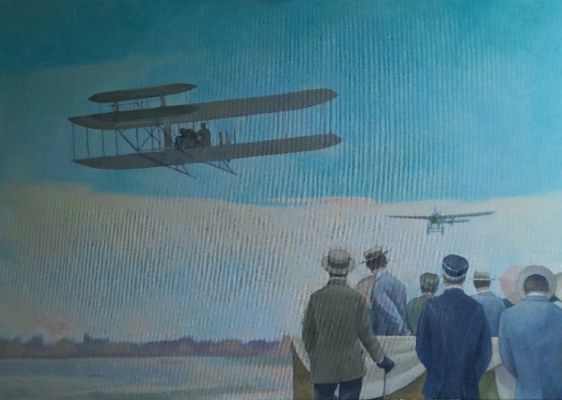
Modern Times
Oil on canvas, 40 x 30 cm, 2023
Franz Kafka had a curious and sporty disposition. During his first stay in Riva del Garda in September 1909, he and his friends Max and Otto Brod attended the 1st Brescia-Montichiari International Air Race. The young author was inspired by that event, writing a long and colourful story titled “The Airplanes at Brescia”, published on 29 September 1909 in Bohemia, a German-language daily newspaper in Prague.
...now comes the plane with which Blériot flew over the Channel; no one has said it, but everyone knows it... The sun has descended towards the horizon, illuminating the hovering wings as it passes under the canopy of the stands. Everyone looks up in admiration; there is no place in any heart for anyone else. He makes a turn and appears almost perpendicularly above us. And everybody twists their necks see how the monoplane sways, how it is grabbed by Blériot and made to soar.
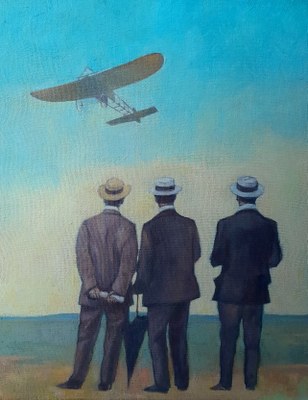
The extraordinary flight of Mr Kašpar in the skies of Bohemia
Oil on canvas, 50 x 70 cm, 2023
As early as April 1910, the Bohemian engineer Jan Kašpar made his first attempt at flying a Blériot aircraft with an Italian Anzani engine, followed in May 1911 by a very successful 120 km flight from the town of Pardubice to Prague. Kašpar's plane, which stirred the enthusiasm of the people of Prague, was exhibited for several days in the public park on Sophie's Island on the river Vltava, a place frequented by Kafka during his solitary walks or with friends. A year earlier, in “The Airplanes at Brescia”, Kafka wrote:
…Max (Brod) makes the correct observation that something similar could and should be organised in Prague. It need not be a flying contest, he says, although that would be interesting, but it should be simple to invite an aviator, and no participant would regret it. It would be easy: Wright is flying in Berlin now, and it would only be a matter of persuading him to make a small detour.
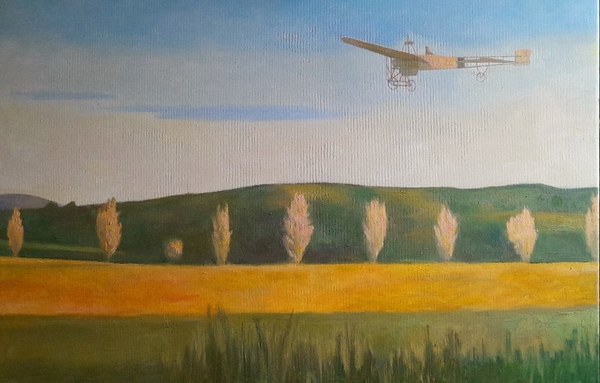
Landscape near Zürau
Acrylic on canvas, 40 x 30 cm, 2024
Between September 1917 and April 1918, Kafka stayed in Zürau, a country village in West Bohemia, as a guest of his sister Ottla. In this pleasant and peaceful place, which gave him hope that he might recover from tuberculosis, Kafka completed the famous Zürau Aphorisms, a series of 109 narrative fragments, parables, thoughts or small images of glimmering purity written on 105 numbered sheets of paper.
…I make an excellent living here...I have no room in the sun, it is true, but a magnificent sunny place where I can lie down. A high ground or rather a small plateau in the middle of a vast semicircular basin...I dominate it and lie there like a king, with the chains of hills rising up about the same height as me...
(Letter to Oskar Baum, September 1917)
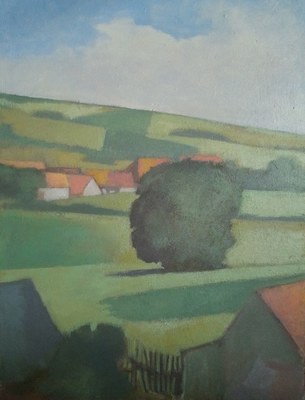
Winter in the Sudetenland
Acrylic on canvas, 40 x 30 cm, 2024
The Sudetenland is the historical name given to the territories that make up the northern, southern and western edges of the present-day Czech Republic. They were inhabited by a German-speaking majority population until 1945. Kafka travelled to northern Sudetenland mainly for professional reasons, as an inspector for the Imperial-Royal Workers' Accident Insurance Institute to check the safety conditions of the region's many small textile, wood, glass and porcelain factories.
…you can't travel by sledge because it costs a lot. And I thought it was free because there is so much snow around...
...i've been to Neustadt at the foot of Tafelfichte... If you take your trousers off, you sink completely into the snow, but if you put them on, the snow rises up to your knees. You could be happy here.
(Diaries, 25.02.1911)
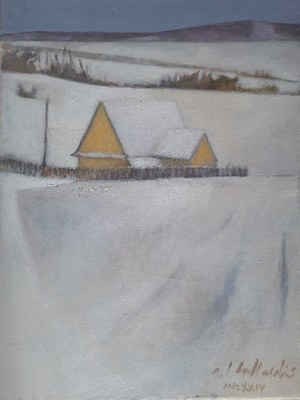
Autumn Landscape with Birds
Oil on canvas, 40 x 30 cm, 2023
Between late summer of 1917 and spring of 1918, Kafka stayed in Zürau (Šiřem in Czech), a village about 80 kilometres from Prague. He was a guest of his sister Ottla, whose husband owned estates in the village. The majority of the few hundred mostly German-speaking people who lived there worked in agriculture, especially hop-growing, essential to the characteristic aroma of Czech beer. Kafka loved to walk in the surrounding countryside, and he used to reach other small villages, such as Oberklee (Soběchleby) or Flöhau (Blšany), by following the dirt roads. With extreme precision, Kafka managed to capture a detail, an atmosphere, a micro-episode of these landscapes and rural life, making them a perfect part of one of his stories, not only as a physical but also as a psychological backdrop.
…Crows claim that a single crow can destroy the sky. This is certain, but it proves nothing about the sky, because the sky means precisely: the impossibility of crows.
(The Zürau Aphorisms, 1918)

Sudeten Landscape with Lake
Oil on canvas, 40 x 30 cm, 2024
The Sudetenland is the historical name given to the territories on the northern, southern and western borders of the present-day Czech Republic. They were inhabited by a majority German-speaking population until 1945. Kafka travelled to northern Sudetenland mainly for professional reasons, as an inspector for the Imperial-Royal Workers' Accident Insurance Institute to check the safety conditions of the region's many small textile, wood, glass and porcelain factories. The region is mountainous along its borders, with dense forests and numerous ponds, lakes, towns and castles perched on hilltops, offering romantic and breath-taking views in all seasons.
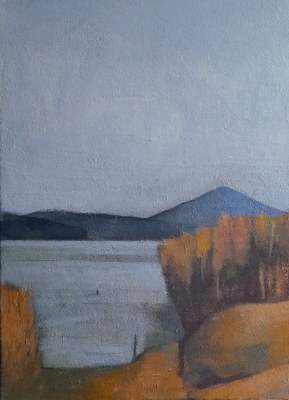
Prague Suite (September Evening in Petřín)
Acrylic on canvas, 30 x 30 cm, 2024
St. Lawrence Hill or Petřín Hill is one of the most prominent elements of the Prague landscape. It overlooks the left bank of the river Vltava, next to the Malá Strana quarter and the city’s Castle with St. Vitus Cathedral. Criss-crossed by many paths, it includes several gardens and city parks. The hill is bordered by the Hunger Wall, an old line of medieval fortifications, and it was the location of some stone quarries, where Franz Kafka set the finale of The Trial. The hill appears in several of his writings, such as in the short story "Description of a Struggle", where it is part of a dreamlike, nocturnal vision.
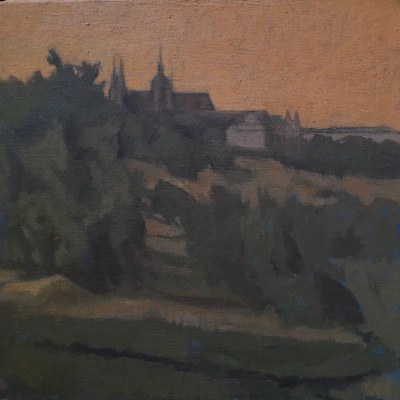
Prague Suite (From the New World)
Acrylic on canvas, 30 x 30 cm, 2024
Nový Svět (New World) is a hamlet of hovels from the medieval and Baroque periods, located near Prague Castle and the Deer Moat. Here, life moves at a slower pace, shielded from the noise and crowds of the capital. There are few patrons of its narrow streets, perfect for quiet strolls in any season of the year—or of the soul.
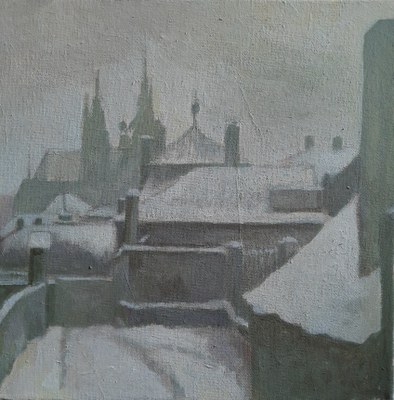
Prague Suite (A Walk in Belvedere Park)
Acrylic on canvas, 30 x 30 cm, 2024
In 1908, a new Art Nouveau bridge was built over the Vltava, allowing people to walk from the Old Town Square along St Nicholas Street (now Paris Street) to a large hillside park with a panoramic view of the entire city. It was one of Kafka’s favourite destinations: he would then walk from this hill to Chotek Gardens and on to the Royal Garden, touching upon the beautiful Belvedere building, the first Renaissance structure of its kind in Bohemia.
…Evening walk with morning thoughts, solid but not trustworthy. Stop at Chotek Park. The most beautiful place in Prague. Birds singing, the castle with the gallery (the Belvedere), the old trees with last year's leaves, the half-light. Later Ottla came with D.
(Diaries, 14.03.1915)
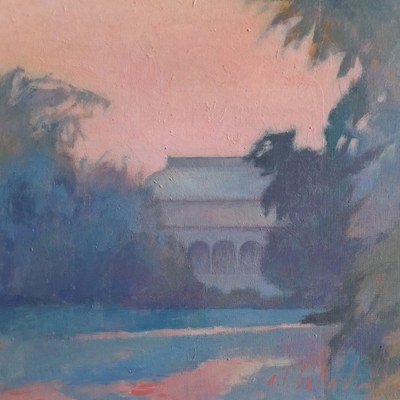
Prague Suite (Charles Bridge Saints)
Acrylic on canvas, 30 x 30 cm, 2024
Held up by the arches of the 14th-century Stone Bridge, or Charles Bridge, the Royal Route runs over the Vltava as it connects the medieval Old Town with the Malá Strana quarter at the foot of Hradčany (Hradschin) Hill and the Castle of the Bohemian Kings. From the 17th century onwards, the bridge was decorated with 30 groups of sandstone statues carved by the best Czech Baroque sculptors. In the centuries that followed, Charles Bridge became a favourite place to take a stroll for the people of Prague. Franz Kafka was inspired by it for a youthful poem (“...people who walk on dark bridges, in front of saints with faint, dim lights...”), he talked about it in his story “Description of a Battle”, and even mentioned it in a diary entry:
…With Ottla. Picked her up from her English teacher. Home across the long river, the stone bridge, a short stretch of Malá Strana, the New Bridge. I was moved by the statues of saints on the Charles Bridge. Strange light of a summer evening when the bridge empties before night.
(Diaries, 19.06.1916)
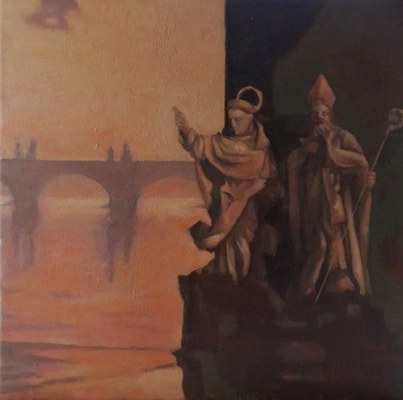
Arrival at Friedland (the Castle)
Acrylic on canvas, 40 x 30 cm, 2024
In February 1911, Franz Kafka was sent on a mission to the Sudetenland on behalf of the Bohemian Imperial-Royal Workers' Accident Insurance Institute. He travelled by train during a particularly snowy season and stayed in the small town of Friedland (Frýdlant), at the foot of the town castle. This old medieval fortress had been transformed into an imposing Renaissance residence, which in the early 17th century belonged to Count Albrecht von Wallenstein, the legendary generalissimo who led imperial troops in the Thirty Years' War. Kafka visited the castle and the park below with great interest, describing it in a few pages of his travel diary. While in Friedland, the writer also identified a school for his sister Ottla, who wanted to study agriculture. The small town, the tavern where he stayed and the mysterious grandeur of the castle served as inspiration when, a few years later, he began to write his famous novel The Castle.
…So he walked on, but it was a long way. For he was in the main street of the village, and it did not lead to Castle Mount but merely passed close to it before turning aside, as if on purpose, and although it moved no further away from the castle, it came no closer either.
(The Castle)
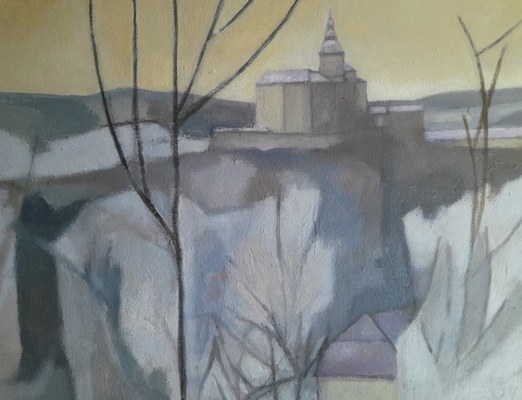
Franz Kafka and Prague
Acrylic on canvas, 80 x 120 cm, 2021, private collection, Bologna
In this painting, the writer is captured as if intently listening to something as he looks out at us, his gaze seeming to come from afar, an indecipherable smile on his face. His head is caught in movement, tilted towards a fleeting dream of which we know nothing. In the centre we see Kafka's Prague: above, the Castle; below, the dancing roofs of the old town, including the easily recognised crenelated profile of the Old-New Synagogue, and then, at the very bottom, the Charles Bridge. The elements are condensed into a single, dreamlike, nocturnal vision. It is possible to imagine Kafka as a passer-by, clinging to the parapet of the old bridge, standing still, scanning the dark waters of a momentous twilight as it marks the start of modern civilisation.
People who walk on dark bridges / in front of saints / with dim, faint lights.
Clouds which drift across a dreary sky / in front of churches / with evanescent towers.
Someone leans against the squared parapet / and looks at the dark evening water /
Their hands on ancient stones.
(Letter to Oskar Pollak, November 1903)
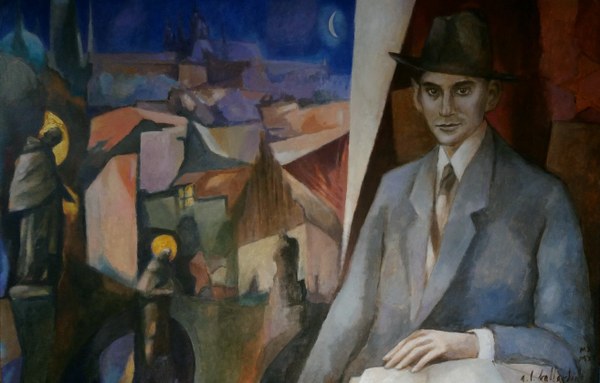
Franz
Acrylic on canvas, 80 x 120 cm, 2021, Museo Ebraico Bologna (MEB)
Prague Castle is a distant dream under a pale moon, while a saint—momentarily still illuminated by his own halo—slips into the river from old Charles Bridge. An ominous form bursts into the painting at the top left. Its broken cry is hurled into the night, a clear reference to Guernica by Pablo Picasso. This figure also alludes to the hallucinated vision at the end of The Trial and is meant to recall the horrors that struck Prague and all of Europe during the century of modernity, horrors which occurred in Kafka’s lifetime but which his illness spared him from seeing. "Evil knows good, but good does not know evil".
(Gustav Janouch, Conversations with Kafka, 1952).
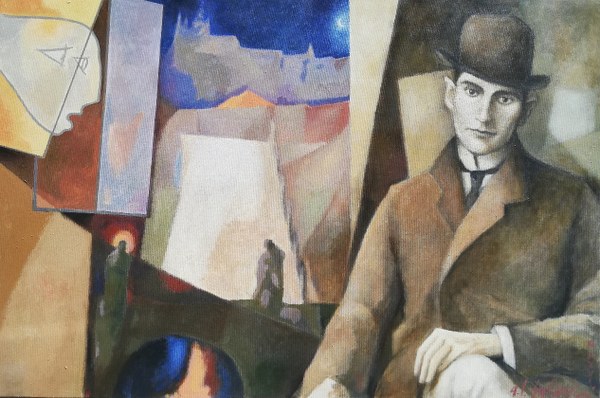
Greetings from Italy, Franz
Acrylic on canvas, 70 x 100 cm, 2024
Franz Kafka made four trips to Italy at different times in his life. The first two (1909 and 1911) were for the pleasure of travelling, to feed his curiosity and imagination, while the last two (1913 and 1920) reflected the need to improve his poor health, undermined by tuberculosis. Kafka got to know Lake Garda and its towns; he visited Brescia, Milan, and the Lombardian lakes; he stopped briefly in Venice and Verona after leaving Trieste; and he stopped in Merano in an attempt to cure his ailing lungs. His diary entry from the beginning of September 1911 mentions the idea of stopping in Genoa, Rimini and, leaving aside Milan, of "travelling from city to city until Bologna" (Diaries, 4 September 1911). Rimini, Bologna...in those weeks, the Bolognese newspaper Il Resto del Carlino was organising a 'great Franco-Italian air on the Bologna-Venice-Rimini-Bologna route at Prati di Caprara. All the major Italian newspapers were talking about it, and perhaps Kafka learned about it from an article in Corriere della Sera while he was in Milan with his friend Max Brod. The event might have interested him, as he had attended the Brescia air race as a spectator two years earlier. But that trip came to nothing, as Franz and Max left Italy for Paris.
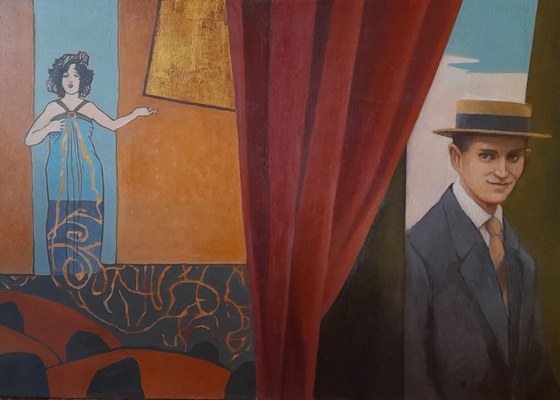
Prague Suite (Alchemists' Alley)
Acrylic on canvas, 30 x 30 cm, 2024
…I moved into Ottla's house, which at that time had just been put in order. In the beginning it had many faults, but I do not have enough time to recount them all. Today I am completely happy with it. To put it bluntly: the nice journey upwards, the silence there. A very thin wall separates me from the neighbour, but the neighbour is quite quiet. I take my dinner with me and usually stay up there until midnight, then it's back home: I just have to decide to stop what I'm doing, and then the walk refreshes my head. And life there: it's something special to have your own home, to lock the door to the world, not that of a room, not that of a flat, but a house; to be able to walk out the door into the snow of the quiet alley. All this for twenty crowns a month, supplied with all the necessities by my sister, served only when necessary by the little flower girl (Ottla's pupil). Everything is perfect and beautiful.
(Letter to Felice Bauer, late December 1916 - January 1917)
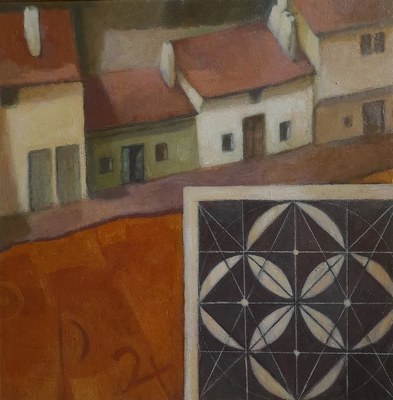
Morning on the Lake
Acrylic on canvas, 70 x 50 cm, 2024
Like many travellers from Central Europe, Kafka's first glimpse of Italy was when he came to Lake Garda and stayed in the town of Riva, which was still part of the Austro-Hungarian Empire. It was in September 1909 and he was travelling with his friends Max and Otto Brod. In 1913, he visited Riva and the area around the lake a second time, alone, staying in a sanatorium from September to mid-October for treatment and also having a small “affair” with an unknown girl. Many of his impressions and precise details of Riva, the harbour and the boats on the lake would serve as the setting for “The Hunter Gracchus”, a metaphysical story of a dead hunter who still wanders the earth because the boat that was to take him to the afterlife cannot find its way. An early trace of the story can be found in his diary entry from 6 April 1917.
